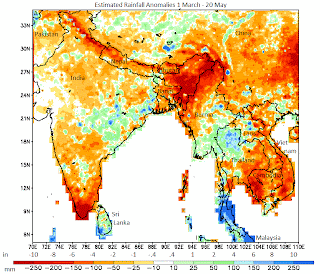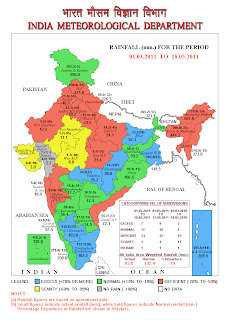It has been very dry so far this season in northeast India. Improvement over the last couple of weeks in Bangladesh and points west has kept this area on track for the start of the growing season. The rains in southern China take a break, reminding us that the drought there is far from resolved. Seasonable weather continued in southeast Asia, although there is some dryness on the mainland. Across the Middle East light, seasonable, showers from Turkey to Iran.
Although the above graphic, from the US weather service, does a good job at overselling the potential drought in northeastern India, it does serve as a good example of the worst case scenario. However, the India Met Department, has released this as their current seasonal tally:
Note that the colors use a percent of normal scale, and that yellow is actually more dire than red. Although the two products differ substantially in the south and in Kashmir, they do match up in the band across central India, including the northeast. Other rainfall estimates are showing reasonable conditions in the "NMMT" region, which comprises of the states Nagaland, Mizoram, Meghalaya, Tripura. So that is the only area that is in dispute in the northeast, and that dispute is not coming from the Indian government, nor my preferred rainfall estimation product. This is a very wet part of the world, and even with substantial deficits it could manage a decent growing season. However, there could also be problems further downstream in Bangladesh.
Rainfall in Bangladesh has been more similar to West Bengal than to northeastern India. However, Bangladesh is very reliant on the rivers coming out of India for fresh water. The main river is the Ganges, and the second most important is the Brahmaputra- and both are having problems. The Brahmaputra comes out of southern China via northeast India, both countries have been having rainfall problems of late. The Ganges comes out of northern India, feeding on the run off and melt water from the Himalayas, including most of Bhutan and Nepal. The dryness upstream from Bangladesh radiates outward from northeast India westward into Bhutan, the northern Gangetic Plain, and Nepal. All of this could reduce water flow down the Ganges, putting a strain on water availability in Bangladesh. Fortunately there are no hydroelectric dams along the Ganges, only one in Madhya Pradesh, Bansagar Dam, is on the Son River, a tributary of the Ganges. Tensions could rise between India and Bangladesh over the amount of water flowing through the Farakka Dam along the border of the two countries if rainfall doesn't improve. The dam is controlled by India.
Dryness extends southward into northern parts of Burma. Rains have been off to an unimpressive start in eastern Thailand, Cambodia, Laos and Vietnam.
The Middle East has has a few light showers across the northern areas, Turkey, the Caucasus and Iran. Seasonable dryness has continued elsewhere including the countries with ongoing protests in Syria, Bahrain and Yemen.



No comments:
Post a Comment